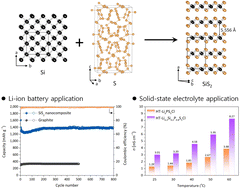Silicon disulfide for high-performance Li-ion batteries and solid-state electrolytes†
Abstract
Layered materials have attracted considerable attention in recent years due to their diverse properties, including tunable bandgaps, valley polarization, and weak van der Waals interlayer forces, which enable a wide variety of promising applications. Among them, silicon disulfide (SiS2) exhibits interesting chemical and physical properties. However, synthesizing SiS2 remains difficult due to the high pressure and temperature requirements and the easy vaporization of the S source. Herein, we establish a simple large-scale synthesis of layered orthorhombic SiS2 using a solid–gas phase reaction. Additionally, it is evaluated for its Li-storage properties as an anode material for Li-ion batteries (LIBs). The SiS2 nanocomposite, which was fabricated using amorphous carbon in a simple mechanical process, has a high lithiation/delithiation capacity of 1610/1363 mA h g−1, high initial coulombic efficiency of 84.7%, extremely high cycling stability after 800 cycles, and high rate capability. Furthermore, SiS2 is incorporated into a Li-argyrodite solid-state electrolyte (Li6PS5Cl, SSE) used in all-solid-state batteries (ASSBs), resulting in commendable air/moisture stability and high ionic conductivity with low activation energy. Accordingly, the large-scale synthesis method, exceptionally high Li-storage characteristics, and remarkable SSE application of the layered SiS2 make it highly suitable for a variety of applications.

- This article is part of the themed collection: 2023 Journal of Materials Chemistry A HOT Papers


 Please wait while we load your content...
Please wait while we load your content...